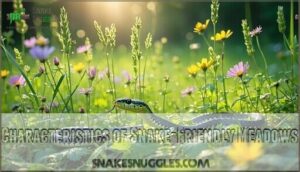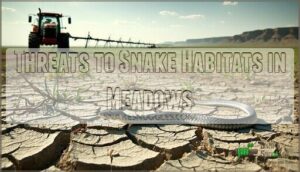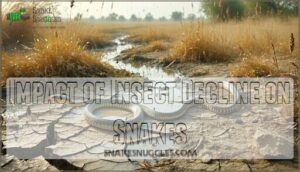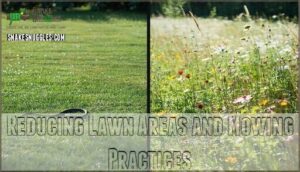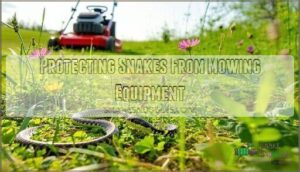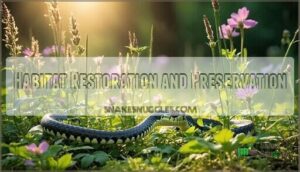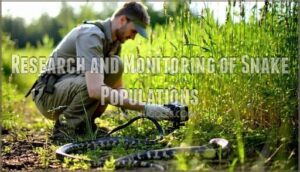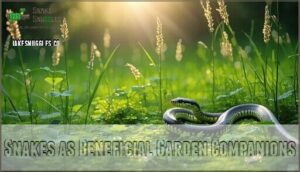This site is supported by our readers. We may earn a commission, at no cost to you, if you purchase through links.
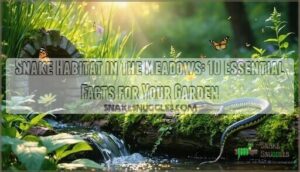
These serpents love moist environments with plenty of cover from rocks, logs, and dense vegetation.
Meadow snakes typically hunt insects, small rodents, and amphibians that flourish in these diverse ecosystems.
They’ll den under stone walls, building foundations, or large rocks during colder months.
Creating pollinator gardens with native plants actually supports the prey species snakes depend on.
Don’t worry—most meadow snakes are completely harmless and actually help control garden pests.
The secret lies in understanding which specific features make certain meadows irresistible to these beneficial creatures.
Table Of Contents
- Key Takeaways
- Types of Meadow Habitats
- Characteristics of Snake-Friendly Meadows
- Threats to Snake Habitats in Meadows
- Impact of Insect Decline on Snakes
- Creating Snake-Friendly Environments
- Conservation Efforts for Snake Habitats
- Snakes as Beneficial Garden Companions
- Snake Species Found in Meadows
- Protecting Snakes From Human Conflicts
- Maintaining Healthy Meadow Ecosystems
- Frequently Asked Questions (FAQs)
- What is the main habitat of a snake?
- Where is the most common place to find a snake?
- Are garden snakes good to have in your yard?
- Which snakes are active during the night?
- How do snakes find prey in meadows?
- What is the lifespan of snakes in meadows?
- How do snakes adapt to seasonal changes?
- What are common snake predators in meadows?
- What time of year are snakes most active in meadows?
- How deep do snakes burrow in meadow soil?
- Conclusion
Key Takeaways
- You’ll create natural pest control by attracting snakes to your meadows through native plantings, moist environments, and shelter features like logs and rocks – they’ll handle rodent and insect problems without chemicals.
- You can transform your property by reducing lawn areas, raising the mowing height to 4+ inches, and planting pollinator gardens with wildflowers that support the insects snakes depend on for food.
- You’re protecting beneficial creatures when you avoid pesticides and maintain diverse native plant species – most meadow snakes are completely harmless and actually improve your garden’s ecosystem balance.
- You’ll prevent conflicts by understanding snake behavior, making noise while walking through tall grass, and learning to identify local species rather than fearing these helpful garden companions.
Types of Meadow Habitats
When you’re planning a snake-friendly garden, understanding different meadow types helps you create the perfect habitat.
Each meadow type offers unique features that attract different snake species and support their survival needs.
Grassy Fields and Meadows
When you think about grassy fields, imagine nature’s perfect snake buffet.
These meadows offer ideal snake habitat where grassland snakes thrive among native grasses and wildflowers.
Your meadow management practices directly impact prey abundance and snake shelters.
Consider these meadow features:
- Dense grassy camouflage for hunting and protection
- Rich insect populations attracted by diverse plants
- Natural snake shelters from fallen logs and vegetation
Meadow snakes depend on this structural complexity for survival and successful reproduction.
Wetland Edges and Marshes
Beyond grassy fields, wetland edges create perfect snake habitats where marsh snakes thrive.
These floodplain habitats and coastal marshes offer water access and abundant amphibian prey for meadow snakes.
Your marsh snake neighbors benefit from three key features:
- Shallow water zones provide hunting grounds for frogs and fish
- Dense vegetation borders offer perfect cover and nesting sites
- Muddy banks create ideal basking spots for temperature regulation
These dynamic snake environments support diverse species year-round.
Native Wildflowers and Grasses
Native wildflowers and grasses create nature’s dining hall for meadow snakes.
These native plantings boost meadow diversity by attracting insects that snakes love to hunt.
Wildflower benefits extend beyond beauty—they support robust food webs.
Different grass varieties provide habitat structure with varying heights and densities.
This combination offers perfect cover for species like garter snakes while maintaining the ecosystem balance your garden meadows need.
Characteristics of Snake-Friendly Meadows
You’ll find that successful snake-friendly meadows share three key characteristics that make them irresistible to our serpentine neighbors.
Think of these features as the "holy trinity" of snake real estate – without them, you’re basically running a vacant lot instead of prime habitat.
Moist and Humid Environments
Snake habitat in meadows thrives on moisture magic.
When humidity hovers around your garden’s edges, you’ll create snake paradise through these wetland wonders:
- Humidity Benefits – Keeps snake skin supple and supports shedding cycles naturally
- Moisture Requirements – Maintains ideal 60-80% humidity levels snakes crave daily
- Wetland Proximity – Connects your snake meadow to water sources within 50 feet
- Humid Microclimates – Creates cool refuges under logs, rocks, and dense vegetation
Adding shallow dishes provides essential water sources for hydration.
Diverse Native Plant Species
Picture dozens of wildflowers carpeting your meadow—that’s snake paradise! Native plant benefits shine when diverse species create habitat structural complexity.
Wildflower diversity supports robust insect-plant interactions, feeding snakes indirectly. Restoring native flora combats plant biodiversity loss, transforming ordinary meadows into thriving snake habitat sanctuaries where native wildflowers flourish naturally.
Presence of Insect Populations
Insect abundance transforms meadows into thriving snake habitats.
You’ll find that diverse pollinators and prey create a bustling food web that supports healthy snake populations.
- Prey Availability: Beetles, caterpillars, and small insects provide essential nutrition for young snakes
- Food Web Connections: Adult snakes hunt rodents that feed on insects in meadows
- Pesticide Impact: Chemical treatments devastate insect diversity and disrupt natural prey cycles
- Pollinator Gardens: Native wildflowers attract beneficial insects that sustain snake habitat ecosystems
Threats to Snake Habitats in Meadows
Unfortunately, your garden’s snake neighbors face serious challenges that could drive them away forever.
Modern development, invasive weeds, and chemical-heavy farming practices are rapidly destroying the meadow habitats these beneficial reptiles desperately need to survive, which is a threat to their survival.
Habitat Loss and Fragmentation
Habitat loss and fragmentation are bulldozing your snake habitat faster than you’d think.
Urban development and agricultural conversion slice meadows into isolated patches, creating deadly obstacle courses for snakes.
Road mortality claims countless lives as serpents cross fragmented landscapes seeking mates and food.
Climate change shifts suitable territories, while grassland management practices often ignore wildlife corridors.
These threats leave snake populations stranded on shrinking habitat islands.
Invasive Vegetation and Weeds
Wild weeds are wreaking havoc in your meadow paradise. Invasive plants like reed canary grass can slash native plant diversity by nearly half, creating barren landscapes where snakes once thrived.
These aggressive invaders form dense colonies, choking out native grasses and wildflowers that support insect populations snakes depend on. One example is Japanese stiltgrass invasion, which spreads in moist, open woods.
Prevention Strategies for effective Weed Control:
- Monitor regularly for early invasive species detection and removal
- Plant diverse native restoration species to outcompete weeds naturally
- Use targeted herbicide applications during peak growth phases
- Maintain soil health through composting to strengthen native plant resilience
- Partner with local conservation groups for coordinated habitat degradation prevention efforts
Agricultural Practices and Pesticide Use
After battling invasive weeds, you’ll find agricultural practices add another twist.
Pesticides and insecticides don’t just keep pests away—they also trigger insect decline and wipe out snake prey.
Agricultural expansion and monocultures lead to habitat degradation.
Try boosting crop diversity and sustainable farming. Even small changes, like cutting back on pesticides, help your meadow’s snakes stick around and thrive.
Impact of Insect Decline on Snakes
You’ve probably noticed fewer bugs hitting your windshield during recent drives—this "windshield phenomenon" signals a dramatic decline in insect populations.
That’s quietly devastating snake communities in meadows, as insects disappear due to habitat loss, pesticide use, and climate change.
Snakes lose their primary food source, creating a ripple effect that threatens the delicate balance of meadow ecosystems, highlighting the critical issue of insect populations.
Windshield Phenomenon and Insect Decline
You’ve probably noticed fewer bugs hitting your windshield lately—that’s the Windshield Phenomenon in action.
This insect decline spells trouble for insect-eating creatures in meadows.
The Insect Population Crash stems from Pesticide Impact, habitat loss, and climate shifts.
These Food Web Effects ripple through snake habitat, threatening the delicate balance that keeps our garden ecosystems thriving.
This is especially concerning given that insect biomass declines by 2.5% annually.
Effects of Insect Decline on Snake Populations
When insect decline hits meadows, snakes face serious Food Web Impacts and Population Bottlenecks. Their snake diet shrinks dramatically, forcing Dietary Adaptations that aren’t always successful.
When meadow insects disappear, snakes starve—their food web collapses from the bottom up.
Reproduction Rates plummet when hungry snakes can’t find enough prey to fuel breeding. Poor Habitat Quality compounds the problem, creating a perfect storm for declining snake populations.
Here’s how insect decline affects snake habitat in meadows:
- snake predators gain advantage when weakened snakes become easier targets
- Juvenile snakes suffer most since they rely heavily on small insects
- Adult snakes must expand hunting ranges, increasing exposure to dangers
- Ecosystem balance tips as fewer snakes mean unchecked pest populations
Role of Pesticides in Insect Decline
Pesticides create a toxic web affecting both insects and snake populations in meadows.
When you spray pesticides, you’re inadvertently starving snakes by eliminating their food source. Neonicotinoid effects disrupt insect nervous systems, while insecticide resistance forces stronger chemicals.
Consider these ecosystem disruption impacts:
- Pesticide exposure kills beneficial insects snakes depend on
- Reduced prey forces snakes to abandon traditional snake habitat areas
- Organic alternatives support healthier meadows with thriving insect populations
Creating Snake-Friendly Environments
You can transform your garden into a snake-friendly haven by making a few thoughtful changes that benefit both you and these helpful reptiles.
Creating the right environment means thinking like a snake – they need food, shelter, and safety from dangers like mowing equipment.
Pollinator Gardens and Native Wildflowers
Since the insect decline threatens snake populations directly, you’ll need to rebuild their food web from the ground up.
Pollinator gardens with native wildflowers like purple coneflower and bee balm create bustling insect communities that snakes depend on.
Your garden design becomes a dinner reservation system – more native plantings means more pollinators, which equals happier, well-fed snakes patrolling your meadows naturally.
You can find various plants for pollinators online.
Reducing Lawn Areas and Mowing Practices
Beyond pollinator gardens, your lawn space holds untapped potential for meadow management.
Reduce traditional turf areas and raise mowing height to create habitat patches. Lower mowing frequency lets native grasses flourish.
Consider lawn alternatives like clover or wildflower mixes. Push mowers offer better control than riding mowers for safe mowing around wildlife areas.
Mower selection matters—choose equipment that allows flexibility in cutting heights for diverse meadows. You can find pollinator garden plants to further enhance the habitat.
Protecting Snakes From Mowing Equipment
Your mower can quickly become a meadow snake’s worst enemy.
Raise your mowing height to at least four inches and choose push mowers over riding equipment for better control.
Timing matters – avoid mowing during peak snake activity in early morning or late afternoon.
Install mower guards or walk your property first to check for basking snakes.
Consider snake relocation if you spot one before cutting.
Conservation Efforts for Snake Habitats
You can’t save what you don’t understand, and that’s exactly why conservation efforts for snake habitats focus heavily on research and education alongside restoration work.
These programs combine habitat preservation projects with community outreach to help people recognize snakes as beneficial neighbors rather than threats.
Habitat Restoration and Preservation
Through thoughtful meadow restoration efforts, you can rebuild critical snake habitats that have vanished over decades.
Habitat Connectivity becomes reality when you create wildlife corridors linking fragmented areas.
- Invasive Control: Remove aggressive weeds choking native plants
- Climate Resilience: Choose drought-tolerant native grasses and wildflowers
- Protected Areas: Designate untouched zones for nesting and shelter
- Community Involvement: Partner with neighbors for larger restoration impact
Research and Monitoring of Snake Populations
Population dynamics tell the real story behind snake numbers in meadows.
Researchers use tracking methods like artificial cover objects and camera traps to monitor elusive species.
Genetic analysis reveals genetic diversity and population health, while habitat mapping shows critical habitat use patterns.
These snake population trends guide conservation impact decisions, helping protect entire snake ecosystems through targeted snake species management strategies.
Education and Awareness About Snake Conservation
While research tracks snake populations, snake education breaks down barriers between humans and these beneficial creatures.
You can launch awareness campaigns that showcase snake facts instead of snake myths — like how garter snakes actually control garden pests rather than threaten your family.
Community engagement through school visits and nature walks teaches proper species identification and safe handling techniques.
When neighbors understand the conservation importance of meadow snakes, they’re more likely to protect rather than harm them.
Snakes as Beneficial Garden Companions
You’ll find that snakes make surprisingly helpful garden partners by naturally controlling pest populations that can damage your plants.
These non-venomous meadow residents quietly hunt rodents, insects, and other small creatures that might otherwise overrun your carefully tended space, acting as natural controllers of pest populations.
Role of Snakes in Controlling Pests
Your meadows become nature’s pest control headquarters when snakes move in.
Transform your garden into a snake sanctuary – nature’s free pest control service has arrived.
These silent hunters tackle rodent control by catching mice and voles that damage plants. They manage insect populations, gobbling up beetles and grubs.
Some species handle amphibian regulation too. This natural pest control creates ecosystem balance without chemicals, making your garden healthier while these beneficial predators work their magic.
To keep them around, consider implementing snake-proof fencing.
Benefits of Snakes in Ecosystems
When you spot snakes in your meadows, you’re witnessing nature’s pest control experts at work.
These ecological superstars maintain ecosystem balance through their essential biodiversity support role.
Here’s how snakes benefit your garden ecosystem:
- Pest control – devour insects and crop-damaging pests
- Rodent regulation – keep mouse and rat populations balanced
- Indicator species – signal healthy meadow environments
- Biodiversity support – maintain complex food webs
- Ecological benefits – preserve natural ecosystem balance
Coexisting With Non-Venomous Snakes
Living with nonvenomous snakes in your garden creates natural pest control harmony.
Safe identification helps distinguish helpful species from venomous ones—learn local varieties through field guides.
When snake sightings occur, observe from distance; most prefer avoiding humans anyway.
If relocation practices become necessary, contact wildlife professionals rather than attempting DIY moves.
Promoting tolerance through education transforms fear into appreciation for these beneficial meadows residents.
Snake Species Found in Meadows
You’ll find several fascinating snake species calling your meadow home, each perfectly adapted to thrive in grassy environments.
From the aptly named smooth greensnake that blends seamlessly with vegetation to garter snakes patrolling wetland edges, these reptiles have turned your garden into their personal paradise.
Smooth Greensnakes and Their Habitat
The smooth greensnake’s camouflage rivals nature’s best magicians—you’ll barely spot one among native grasses and wildflowers.
These meadows residents face serious challenges from habitat loss, making habitat restoration essential for their survival.
- Diet consists primarily of insects, spiders, and small invertebrates found in meadow vegetation
- Predators include birds of prey, larger snakes, and mammals that hunt in grassland areas
- Molting occurs regularly as they grow, shedding their bright green skin in meadow hideouts
- Hibernation happens underground or in rock crevices during cold winter months
- Camouflage makes them nearly invisible when motionless among green vegetation and flowers
Other Snake Species in Meadow Ecosystems
Your meadow’s a bustling neighborhood where Garter Snakes patrol wetland edges while Milk Snakes handle rodent control duties.
Rat Snakes climb through tall grasses, and Water Snakes stick near moist areas.
Some regions host Meadow Vipers, though they’re rarer.
Each snake species fills its own niche in meadow wildlife, creating balanced habitat management naturally.
Identifying Snake Species in Your Area
Wondering what’s slithering through your backyard meadow? Local Snake ID starts with observing key features that separate harmless helpers from potential threats.
Here’s your identification toolkit:
- Snake Markings – Look for patterns, colors, and head shape (triangular often means venomous)
- Behavior Clues – Non-venomous snakes typically flee quickly when disturbed
- Regional Variations – Use local field guides since snake species vary by location
Snake identification apps can help distinguish venomous or not instantly. Most meadows host beneficial species that prefer their snake natural habitat undisturbed.
Protecting Snakes From Human Conflicts
You’ll need to balance creating welcoming snake habitats with preventing potentially dangerous encounters in your garden.
Learning proper conflict prevention and safe handling techniques protects both your family and these beneficial creatures from unnecessary harm.
Preventing Snake Encounters and Conflicts
Understanding snake encounters starts with proper preparation—you can’t fight what you don’t know! Stay vigilant while walking through tall grass, wear boots, and make noise to give snakes advance warning.
Education programs teach families that most snake encounters stem from simple misconceptions about snake behavior.
| Prevention Strategy | Why It Works |
|---|---|
| Make noise while walking | Gives snakes time to retreat naturally |
| Keep grass short near homes | Reduces hiding spots and shelter options |
| Remove brush piles | Eliminates prime snake habitat areas |
Human-snake coexistence thrives when you understand their patterns and respect their space.
Safe Handling and Relocation of Snakes
When encountering snakes in your meadow, proper technique makes all the difference for everyone’s safety. Snake handling requires the right approach and equipment to protect both you and our scaly neighbors.
Here’s your safe relocation playbook:
- Use safe equipment – Snake hooks or long-handled tongs keep safe distances while preventing bite incidents
- Master snake identification – Knowing species helps determine handling methods and legal considerations for protected snakes
- Follow expert relocation – Move snakes short distances to similar habitat, respecting local wildlife laws and snake safety protocols
Using the appropriate specialized relocation gear enhances safety. Professional training teaches standardized techniques that address common snake misconceptions while ensuring successful, stress-free relocations.
Avoiding Intentional Killing of Snakes
Despite common snake misconceptions, these creatures won’t attack unprovoked—they’re actually nature’s pest control heroes.
Respecting snakes means choosing snake relocation over killing. Promoting coexistence benefits everyone: you get free rodent control while snakes stay safe.
Snake education reveals their gentle nature. When ethical considerations guide our actions, human-snake coexistence becomes surprisingly easy and mutually beneficial.
They also improve gardens by enhancing soil health through burrowing.
Maintaining Healthy Meadow Ecosystems
You can create thriving meadow ecosystems by balancing your land use with the natural habitat needs that support local snake populations.
When you preserve native plants and limit chemical inputs, you’re building a biodiversity hotspot that benefits snakes, insects, and countless other wildlife species.
Balancing Human Activities and Snake Habitats
Creating harmony between your daily activities and snake habitat isn’t rocket science, but it does require some thoughtful planning. Mowing impacts can devastate snake populations if you’re not careful about timing and technique.
Development encroachment threatens meadows daily, but you can fight back by choosing habitat restoration over traditional landscaping. Responsible agriculture means thinking beyond profit margins to take into account the critters sharing your space. Unfortunately, road mortality and the illegal pet trade continue harming snake populations, making your conservation efforts even more valuable.
To further encourage their presence, consider adding rock piles for shelter.
Here’s how you can champion human-wildlife coexistence in your own backyard:
- Schedule mowing during snake dormancy periods (late fall/early winter)
- Leave unmowed buffer zones around wetlands and wooded areas
- Create wildlife corridors connecting fragmented meadows
- Use elevated mowing techniques that allow escape routes
- Install wildlife crossing structures near roads
Smart planning prevents habitat loss while letting you enjoy your property. When you work with nature instead of against it, everyone wins.
Preserving Native Plant Species and Insects
Native plants are your meadow’s MVPs, supporting Native Plant Diversity and creating robust Insect Food Sources.
When you choose wildflowers over exotic species, you’re building Habitat Interconnections that snakes depend on.
Pollinator Conservation through native plantings strengthens Ecosystem Resilience, ensuring insects thrive without pesticides.
This creates the perfect buffet for meadow snakes while maintaining nature’s delicate balance.
Supporting Biodiversity in Meadow Ecosystems
You’ll transform your property into a thriving ecosystem by supporting meadow biodiversity.
Native plant diversity creates the foundation for healthy predator-prey dynamics and resilient habitat structural complexity.
- Plant native wildflowers – they’re magnets for pollinators and create natural meadow food webs
- Maintain insect population health – skip pesticides to keep the buffet open for snakes
- Embrace structural variety – mix grasses, shrubs, and open patches for maximum habitat appeal
This approach turns your meadow into nature’s apartment complex, where every creature finds their perfect home while contributing to the neighborhood’s success.
Frequently Asked Questions (FAQs)
What is the main habitat of a snake?
When you’re searching for slithering neighbors, you’ll discover their main habitat isn’t just one place—snakes adapt brilliantly.
They prefer meadows with native grasses, wetland edges, and areas offering shelter like logs and rocks for survival.
Where is the most common place to find a snake?
You’ll most often spot snakes in areas with dense vegetation, shelter, and prey sources.
Think meadows, gardens, woodlands, and wetland edges where they can hide under rocks, logs, or thick grass while hunting insects and small animals nearby.
Are garden snakes good to have in your yard?
Yes, garden snakes are excellent yard companions!
They’re nature’s pest control, eating rodents and insects that damage plants.
You’ll have fewer mice, slugs, and harmful bugs naturally.
They’re harmless to humans and pets.
Which snakes are active during the night?
Like shadows gliding through moonlit gardens, nocturnal snakes such as ball pythons, night snakes, and many pit vipers emerge after dark.
You’ll spot them hunting prey, moving between territories, or simply taking advantage of cooler nighttime temperatures for ideal activity.
How do snakes find prey in meadows?
Snakes rely on their keen senses to hunt effectively.
You’ll find they use their forked tongues to "taste" chemical trails, detecting prey through scent particles.
Their heat-sensing abilities help locate warm-blooded animals hiding in dense vegetation, utilizing their keen senses to hunt effectively.
What is the lifespan of snakes in meadows?
Like ancient Romans consulting oracles, you’ll find meadow snakes typically live 4-8 years in the wild, though some species can reach 15 years with favorable conditions and minimal threats.
How do snakes adapt to seasonal changes?
You’ll notice snakes becoming less active as temperatures drop, often seeking warmer spots like sun-soaked rocks or underground burrows. They’ll slow their metabolism and enter brumation during winter months.
What are common snake predators in meadows?
Birds of prey, mammals, and other snakes pose the biggest threats to your slithery neighbors.
Hawks, owls, foxes, raccoons, and larger snakes like kingsnakes regularly hunt meadow dwellers, making survival quite the balancing act, as these predators are a major challenge for the meadow dwellers.
What time of year are snakes most active in meadows?
Spring through early fall brings peak snake activity in meadows.
You’ll spot them most during warm, humid days when they’re hunting insects and small prey.
They’re less active during winter’s chill, and one key factor is the warm weather that influences their activity.
How deep do snakes burrow in meadow soil?
Ever wonder where these slithery neighbors disappear when they’re not sunbathing?
Most meadow snakes don’t actually burrow deep—they’ll slip under logs, rocks, or into shallow depressions just a few inches down, preferring ready-made hideouts over serious digging.
Conclusion
Understanding snake habitat in the meadows transforms your perspective from fear to fascination.
You’ve discovered how these remarkable creatures depend on diverse ecosystems filled with native plants, adequate moisture, and abundant prey.
By creating pollinator gardens, reducing excessive mowing, and preserving natural spaces, you’re supporting beneficial snakes that control garden pests.
Remember, most meadow snakes pose no threat to humans.
Your thoughtful habitat management guarantees thriving snake populations while maintaining beautiful, biodiverse meadow environments for generations to enjoy, filled with native plants.
- https://animalia.bio/common-garter-snake
- https://extension.missouri.edu/media/wysiwyg/Extensiondata/Pro/4h/Docs/Projects/OutdoorsNature/AmphibiansReptiles/Y6130-Snakes-of-Missouri.pdf
- https://hedgelink.org.uk/cms/cms_content/files/36_grass_snakes_&_hedges_leaflet.pdf
- https://bhwp.org/explore/special-habitat-areas/meadow/
- https://oaklandcountyblog.com/2020/06/26/northern-water-snakes-facts-fiction-and-phobias/

